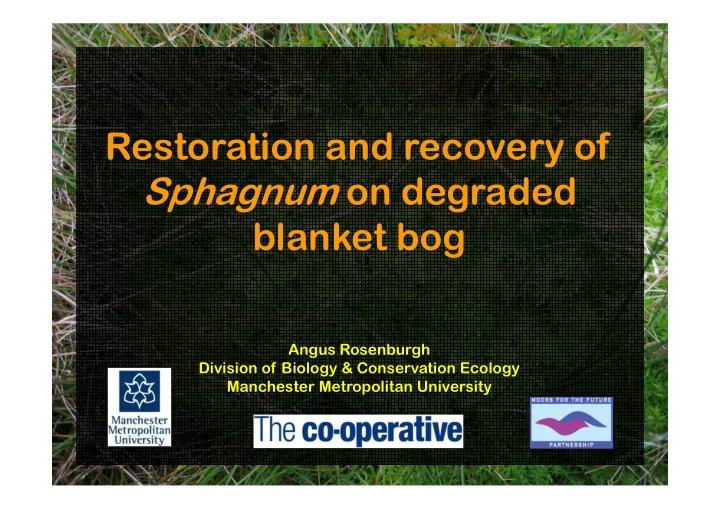

Restoration and recovery of Sphagnum on degraded blanket bog Angus Rosenburgh Division of Biology & Conservation Ecology Manchester Metropolitan University
Where?
Where did it go? � Pollution post-industrial revolution � Inappropriate land management � Stocking density too high � Poor burning regime � Wildfire � Deliberate/ Accidental � Natural
Where did it go? Atmospheric mean annual SO 2 600 Manchester 500 Holme Moss 400 µg m-3 300 200 100 0 1950 1960 1970 1980 1990 2000 2010 Data from Ferguson & Lee, 1983
Where did it go? 70 60 -3 ) Gas Concentration (ugram m 50 Ozone 40 NO2 30 SO2 20 10 0 1988 1990 1992 1994 1996 1998 2000 2002 2004 Year Data from the UK Air Quality Archive
What are the problems now? � Large, bare peat areas � Lack of suitable propagules � Harsh environmental conditions � Legacy of industrial pollution
However... � Not all bad news � Natural recovery 18 Holme Moss 1983-4 16 Holme Moss 2005 14 12 Species / Varieties 10 8 6 4 2 0 Sphagnum Other mosses Liverw orts Total bryophytes Caporn et al ., 2006
Penny Anderson Associates, Moors for the Future, Natural England, Manchester Metropolitan University
How to improve? � Limiting factor - Sphagnum propagules � Introduce more! � Brash � Sphagnum mulch � � Each method has its pros and cons
Where, when & how? � Sphagnum species trial � Seasonality � S.cuspidatum � Sowing � S.fallax � November ‘09 � S.fimbriatum � April ‘10 � S.palustre � August ‘10 � S.papillosum � September ‘10 � Different substrates � Indoor experiment � Bare � Holme Moss peat � Treated � Commercial peat � Intact � Climate eliminated
Sphagnum propagule source � Heather brash � Sphagnum mulch / Harvested Sphagnum � � Heather brash, Sphagnum mulch + heather brash, BeadaMoss ( S.fallax + S.palustre ) + heather brash � Bare and treated surfaces � Indoor experiment on Holme Moss and commercial peat
Species and seasonality trials � Proven success in preliminary trials � Hard winter � Tough summer � Beads still present in the field Photos by S.Hinde
Sphagnum propagule source trial � Applied thickly � Mobile peat surface � Grass barrier
Indoor trials � Answer specific questions � Still poorer performance Commercial peat Holme Moss peat
Sphagnum mulch- Commercial peat
Sphagnum mulch- Holme Moss peat
Peat chemistry
Drought experiment � Desiccation is problem � Series of bead treatments, S.fallax and S.palustre � Improve drought resistance � Growth cabinet- highly controlled environmental conditions
Drought experiment
What next? � Micro-climate importance & provision � Facilitation experiment � Alternative degraded bog sites � Molinia � Peat pans � Diversification � Lowland raised bog (cutting, forestry, etc.) � All related to environmental variables; physical, chemical, meteorological, etc. � Complete just in time to provide guidance to MoorLIFE
Acknowledgements � Thanks to the Co-Operative Foundation and Moors for the Future Partnership for funding this work � Thanks to: Matt Buckler Simon Caporn Neal Wright Stephanie Hinde
Recommend
More recommend